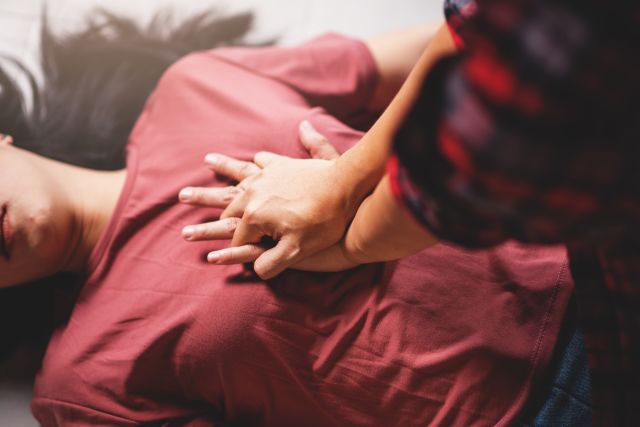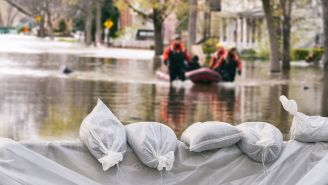Updated on May 20, 2024.
Would you be prepared to handle a health emergency if one unfolded right before you?
Most people don’t have a plan (or emergency know-how) beyond calling 911. But the fact is, an ambulance takes an average of seven minutes to arrive from the time you call 911. Response time can range from 14 to as many as 30 minutes in rural areas.
What should you be prepared to do while you’re waiting? As the Federal Emergency Management Agency (FEMA) tells us: You are the help until help arrives.
Learn CPR and how to use an AED
Sudden cardiac arrest (SCA) occurs when the heart suddenly and unexpectedly stops beating, typically as a result of an electrical malfunction in the heart that causes an irregular heartbeat, called arrhythmia. When the heart stops beating, oxygen no longer flows through the bloodstream to vital organs.
Even four minutes without oxygen to the brain can cause permanent brain damage. Death may occur after 8 to 10 minutes. In the United States, about 356,000 adults and children experience out-of-hospital cardiac arrests (OHCA) each year, which means the heart malfunction occurs when someone is not within easy reach of trained medical staff.
Given how dangerous SCA can become in just a few minutes, an ambulance will often arrive too late. Between 70 and 90 percent of people with OHCA will die before they get to the hospital. That means that the survival of someone experiencing SCA typically depends on administering cardiopulmonary resuscitation (CPR) before the ambulance arrives.
The good news? A bystander who knows CPR and applies it can double or even triple the chances of survival of someone in distress.
Everyone should consider learning CPR and how to use an automated external defibrillator (AED) by taking a class with the Red Cross or American Heart Association.
Safely stop any bleeding
You’ve probably heard that if someone has a cut that’s bleeding, you should make a tourniquet to stop the blood flow. Not necessarily so.
Instead, try to stop the bleeding by applying pressure and elevating the injured area higher than the level of the heart. That means if the cut is in the leg, lay the person on the ground and elevate their leg.
When applying pressure, it’s best to use sterile gauze, but if it’s not available, grab a clean towel or t-shirt. If the wound is very deep or wide, pack or stuff the injury with clean gauze or cloth before applying pressure. Doing so consistently helps a clot form. Push hard, especially if it’s a very rapid bleed, and hold it until medical responders arrive.
That said, there are a few situations where it can be harmful to apply pressure:
- If there’s an object embedded in the injury
- If there’s an injury to an eye
- If there’s a head wound, especially if it’s possible there is a skull fracture
In these cases, wrap the wound with a thick bandage.
If the wound is on the leg or arm and if applying pressure doesn’t stop or slow the bleeding, and if the wound dressing has become soaked in blood, only then do you need to apply a tourniquet. If you have to do so, it’s best to use a tourniquet included in a trauma first aid kit, rather than making your own.
To apply it, tie the tourniquet around the limb as tightly as you can, at a location between the wound and the heart. Never tie a tourniquet around a joint. Twist the tourniquet handle (known as a windlass, or rod) until the bleeding stops, secure it, and then note what time you did so.
Do not move an injured person
Physical trauma can be made worse when well-intentioned friends or bystanders try to move an injured person or make them more comfortable. Unless someone is in a truly dangerous setting, like in the middle of a roadway, a fire, or submerged in water, leave them in place until help arrives.
Know the ‘back blow’ maneuver for choking
You’ve probably heard of the Heimlich maneuver (or seen it performed on TV), and you may have a good feeling you could do it yourself if you needed to. But the American Red Cross recommends doing a simpler move first: back blows.
Start by leaning the choking person slightly forward. Then, using the heel of your hand, hit their back five times just between the shoulder blades.
If that doesn’t dislodge the object, it’s time to try the Heimlich:
- Stand behind the choking person.
- Reach around their torso and grab your fist at the level of their navel.
- Give five quick, upward abdominal thrusts.
Repeat the cycle of five back blows and five thrusts until the person coughs out the object or loses consciousness, at which point you should start CPR.
Know the signs of a stroke
When someone is having a stroke, getting help fast can help decrease the amount of damage it may cause. A person experiencing a stroke may suddenly have trouble with several basic functions. These may include:
- Sight, in one or both eyes
- Speaking or understanding speech
- Walking
- General coordination
Watch out for signs of confusion, as well as sudden weakness or numbness in the face, arm, or leg—particularly if it’s only on one side of the body. A sudden severe headache, especially when there isn’t a known reason for it, can also be a sign.
Call 911 right away if you notice signs of a stroke.
Be prepared to respond to a seizure
As many as 10 percent of people might have a seizure at some point in their lifetimes, according to the Centers for Disease Control and Prevention (CDC). There are many types of seizures, but no matter what type it is, most of the time it will be over after a few moments.
If you witness someone having a seizure, stay calm, and stay with the person until it ends. Check and record what time it began and check the person to see if they are wearing a medical bracelet, which will indicate whether they have an existing condition that makes them more prone to seizures.
If they’re shaking and jerking, it might be a tonic-clonic (grand mal) seizure. If they are standing, ease them carefully to the ground. If they are on the ground, turn them gently onto one side and loosen any scarves or ties wrapped around their neck to help them breathe. Put a folded jacket or something soft under their head.
Call 911 immediately if you determine whether any of these conditions are true:
- The person has never had a seizure before
- The seizure lasts longer than 5 minutes
- The person is hurt during the seizure
- The seizure takes place in water
- The person has another serious health condition or is pregnant
- The person has trouble breathing or waking up after the seizure
After the seizure passes, calmly explain to the person what happened, and help them get home or to a safe place.
Keep 325 mg aspirin on hand
In the case of a heart attack, cells and platelets in the blood form a clot that blocks blood flow, causing a dangerous shortage of oxygen to the heart. A simple aspirin can reduce that clot formation in as little as five minutes.
If you think a loved one is having a heart attack, call 911 first. Then, if they’re not allergic to aspirin or haven’t been told to avoid it, have them chew the pill (which allows the active ingredient to absorb more quickly into the bloodstream than swallowing the pill whole). This can help thin their blood.
Knowing these seven tips can help you feel prepared in case you witness an accident or sudden illness—and may even help you save a life.







